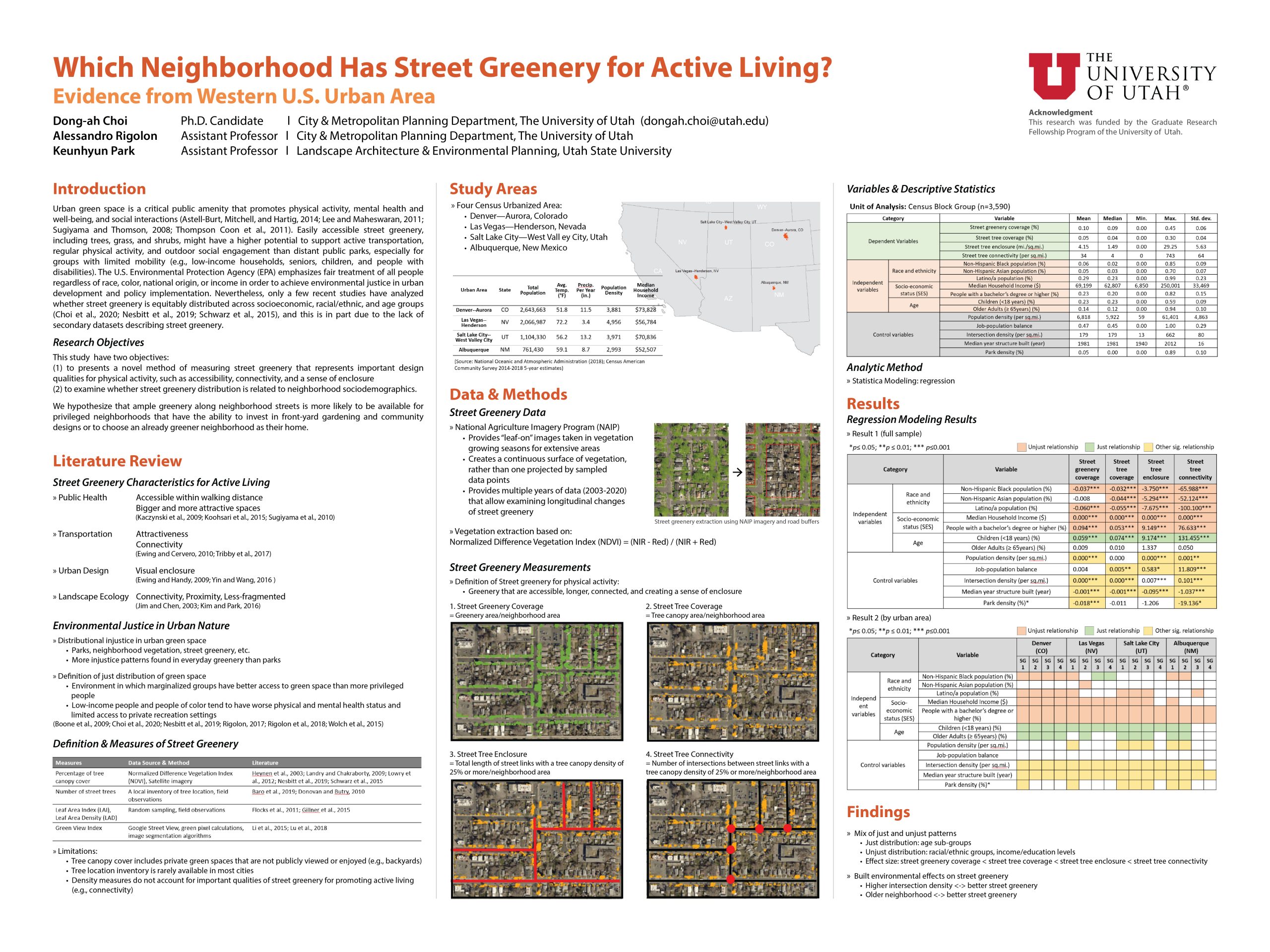Which Neighborhood Has Street Greenery for Active Living?: Evidence from Western U.S. Urban Areas
– Dong-ah Choi, Alessandro Rigolon, Keunhyun Park
[bs_collapse id=”collapse_4ff7-f093″]
[bs_citem title=”Bio” id=”citem_accf-479d” parent=”collapse_4ff7-f093″]
Dong-ah Choi is a doctoral candidate in the Department of City & Metropolitan at the University of Utah. Before seeking a doctoral degree, she earned her bachelor’s and master’s degrees in Landscape Architecture at Seoul National University. In her master’s thesis, she studied diverse uses of street green spaces in new towns in relation to abutting land use. Her doctoral study focuses on the connection between street-level greenery and active living lifestyles. Her research interests span healthy community design, active living, environmental justice, urban green spaces, spatial analytic methods, and automated data collection approaches measuring activity-friendly environmental characteristics.
[/bs_citem]
[bs_citem title=”Abstract” id=”citem_8951-d3c4″ parent=”collapse_4ff7-f093″]
Urban green space is a critical public amenity that promotes physical activity, mental health and well-being, and social interactions. Easily accessible street greenery, including trees, grass, and shrubs, might have a higher potential to support active transportation, regular physical activity, and outdoor social engagement than distant public parks, especially for groups with limited mobility. Nevertheless, only a few recent studies have analyzed whether street greenery is equitably distributed across socioeconomic, racial/ethnic, and age groups
This study presents a novel method of measuring street greenery that represents important design qualities for physical activity, such as accessibility, connectivity, and a sense of enclosure, and examine whether street greenery distribution is related to neighborhood sociodemographics. These analyses will help practitioners better understand the availability of the existing street greenery across a city and contribute to finding areas for greenery improvements.
[/bs_citem]
[bs_citem title=”Narrative” id=”citem_a9f9-0422″ parent=”collapse_4ff7-f093″]
Urban green space is a critical public amenity that promotes physical activity, mental health and well-being, and social interactions) Easily accessible street greenery, including trees, grass, and shrubs, might have a higher potential to support active transportation, regular physical activity, and outdoor social engagement than distant public parks, especially for groups with limited mobility (e.g., low-income households, seniors, children, and people with disabilities). The U.S. Environmental Protection Agency (EPA) emphasizes fair treatment of all people regardless of race, color, national origin, or income in order to achieve environmental justice in urban development and policy implementation. Nevertheless, only a few recent studies have analyzed whether street greenery is equitably distributed across socioeconomic, racial/ethnic, and age groups, and this is in part due to the lack of secondary datasets describing street greenery.
This study (1) presents a novel method of measuring street greenery that represents important design qualities for physical activity, such as accessibility, connectivity, and a sense of enclosure, and (2) examine whether street greenery distribution is related to neighborhood sociodemographics. We hypothesized that ample greenery along neighborhood streets is more likely to be available for privileged neighborhoods that have the ability to invest in front-yard gardening and community designs or to choose an already greener neighborhood as their home.[/bs_citem]
[/bs_collapse]

